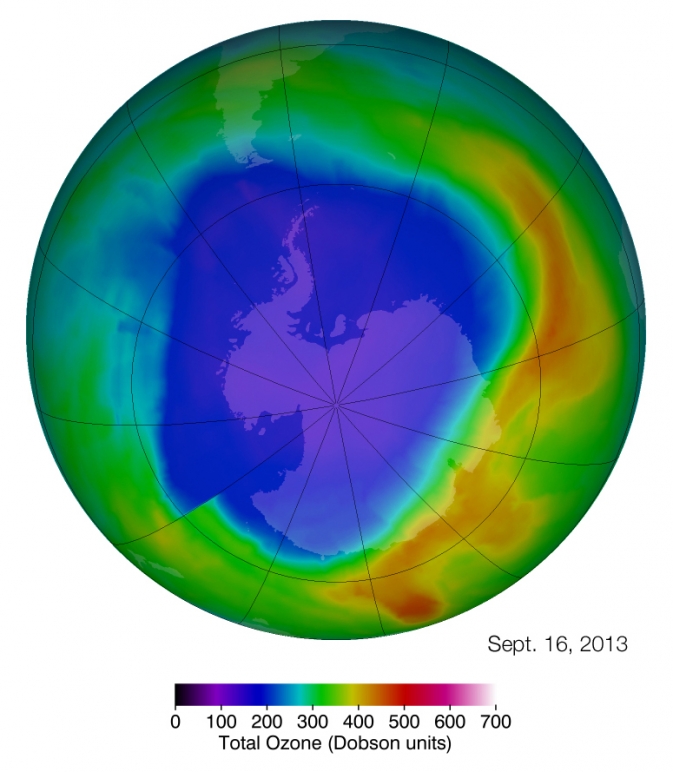 Those who are old enough, may recall the fierce political fight over the 1987 Montreal Protocol to phase out ozone-depleting chlorofluorocarbons (CFCs). Scientists as far back as 1978 had discovered a link between CFCs and destruction of the Earth’s protective ozone layer. Well, good news this week from NASA, who has reported that the hole in the stratospheric ozone is smaller than normal this year. This from NASA,
Those who are old enough, may recall the fierce political fight over the 1987 Montreal Protocol to phase out ozone-depleting chlorofluorocarbons (CFCs). Scientists as far back as 1978 had discovered a link between CFCs and destruction of the Earth’s protective ozone layer. Well, good news this week from NASA, who has reported that the hole in the stratospheric ozone is smaller than normal this year. This from NASA,
The ozone hole that forms each year in the stratosphere over Antarctica was slightly smaller in 2013 than average in recent decades, according to NASA satellite data.
The ozone hole is a seasonal phenomenon that starts to form during the Antarctic spring (August and September). The September-October 2013 average size of the hole was 8.1 million square miles (21 million square kilometers). For comparison, the average size measured since the mid-1990s when the annual maximum size stopped growing is 8.7 million square miles (22.5 million square kilometers). However, the size of the hole in any particular year is not enough information for scientists to determine whether a healing of the hole has begun.
“There was a lot of Antarctic ozone depletion in 2013, but because of above average temperatures in the Antarctic lower stratosphere, the ozone hole was a bit below average compared to ozone holes observed since 1990,” said Paul Newman, an atmospheric scientist and ozone expert at NASA’s Goddard Space Flight Center in Greenbelt, Md.
The ozone hole forms when the sun begins rising again after several months of winter darkness. Polar-circling winds keep cold air trapped above the continent, and sunlight-sparked reactions involving ice clouds and chlorine from manmade chemicals begin eating away at the ozone. Most years, the conditions for ozone depletion ease before early December when the seasonal hole closes.
Levels of most ozone-depleting chemicals in the atmosphere have gradually declined as the result of the 1987 Montreal Protocol, an international treaty to protect the ozone layer by phasing out production of ozone-depleting chemicals. As a result, the size of the hole has stabilized, with variation from year to year driven by changing meteorological conditions. [Full article here.]
Despite significant opposition to the Protocol by many within his cabinet, Ronald Reagan decided to support the controversial international treaty. It turns out the scientists were correct, and so was the President. An interesting history of Reagan’s decision and the tumultuous in-fighting within his cabinet at the time can be found here. A comprehensive history, with links to scientific, policy, and media sources, provided by UNEP, can also be found here. Reflecting back almost a quarter-century ago, and laying witness to the environmental success of that momentous decision, there can be little doubt that Reagan made the right one. A difficult one, but the right one. Failure to act then would have surely consigned many to premature deaths, among other harms to natural systems and the economy.
If we are to learn from our past, those who, today, argue that we humans are so insignificant as to be unable to affect earth’s balance, should take note of history.

